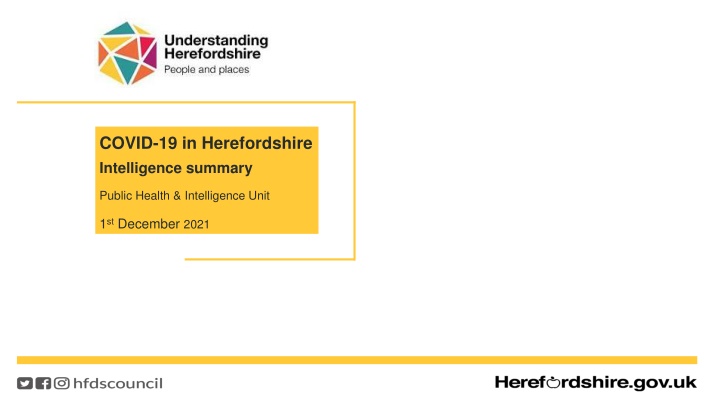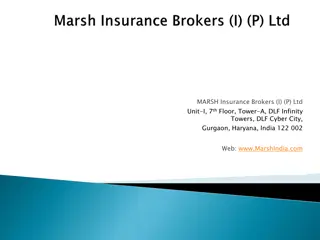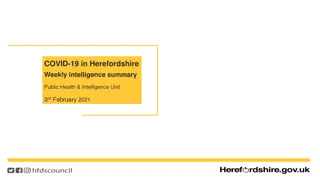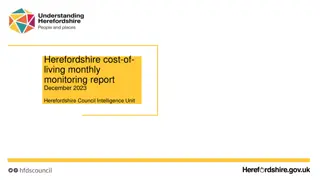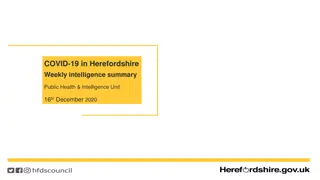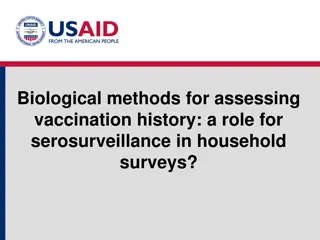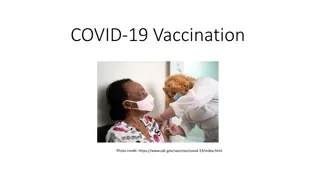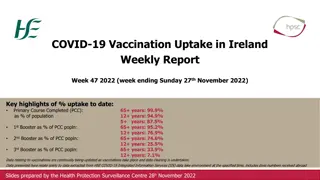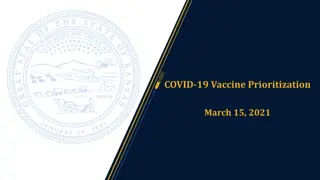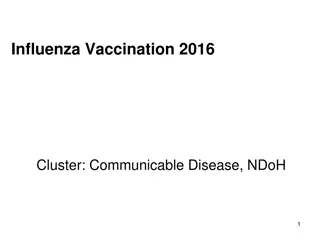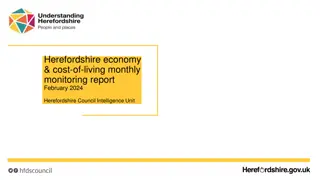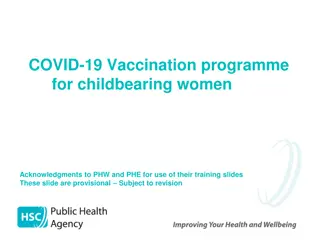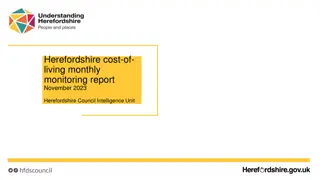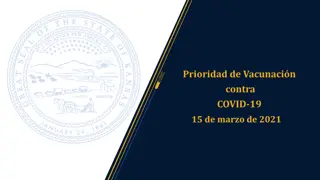COVID-19 Update in Herefordshire: Key Messages and Vaccination Progress
In Herefordshire, a new COVID-19 variant, Omicron, has emerged, prompting government interventions such as compulsory face coverings in certain settings and increased testing requirements for international arrivals. Vaccination progress shows encouraging numbers for first and second doses, but there are disparities in uptake among different age groups and areas. Stay informed and follow guidance to protect yourself and others from the virus.
Download Presentation

Please find below an Image/Link to download the presentation.
The content on the website is provided AS IS for your information and personal use only. It may not be sold, licensed, or shared on other websites without obtaining consent from the author.If you encounter any issues during the download, it is possible that the publisher has removed the file from their server.
You are allowed to download the files provided on this website for personal or commercial use, subject to the condition that they are used lawfully. All files are the property of their respective owners.
The content on the website is provided AS IS for your information and personal use only. It may not be sold, licensed, or shared on other websites without obtaining consent from the author.
E N D
Presentation Transcript
COVID-19 in Herefordshire Intelligence summary Public Health & Intelligence Unit 1st December 2021
Contents 1. 2. 3. 4. 5. 6. 7. 8. 9. Key messages (slides 3-4) COVID-19 testing (slides 5-6) COVID-19 cases (slides 7-8), including demographics (slide 9-10) and local areas (slides 11-12) Variants of concern (slide 13) Vaccinations: uptake (slides 14-17) Patients admitted to hospital (slide 18) Profile of deaths: published data (slide 19) Effects of lockdown on population movement (slide 20) Other resources (slide 21) If you need help to understand this document, or would like it in another format or language, please contact us on 01432 261944 or e-mail researchteam@herefordshire.gov.uk
Covid-19 in Herefordshire: key messages, 01 December. On 23 November, a small cluster of cases infected with a new variant with large numbers of mutations was detected on the international genomic database, GISAID, and designated B.1.1.529. On 26 November, the World Health Organization designated the variant Omicron and classified it as a variant of concern (VOC). In light of the emergence of this new variant the government has announced that: face coverings will be compulsory in shops and on public transport from Tuesday 30 November. Pubs and restaurants will be exempt, as are places of worship. You can find the full list of venues covered here. the number of countries on the 'red list had been increased, the list of which you can find here. all international arrivals must take a Day 2 PCR test and self-isolate until they receive a negative result. individuals notified by NHS Test and Trace or a public health official that they are a close contact of a confirmed or suspected case of the COVID-19 Omicron variant will be legally required to self-isolate, regardless of their age or vaccination status and that all international arrivals are required to take a Day 2 PCR test and self-isolate until they receive a negative result. The COVID-19 vaccination programme will be accelerated, with more people becoming eligible for second and booster doses. Full details of the changes can be found here. The Government is strongly advising that face coverings should be worn in communal areas in all educational settings by staff, visitors and pupils or students in year 7 and above, unless they are exempt. They should also continue to wear face coverings on dedicated school transport unless they are exempt. Department for Education has updated its guidance.
Covid-19 in Herefordshire: key messages, 01 December Both the COVID-19 Response: Autumn and Winter Plan 2021 and the response to the Omicron variant rely on effective vaccination coverage, and all eligible individuals are encouraged to take up both doses of their vaccine and their booster dose. The second dose more than doubles the resistance against developing symptoms, and considerably reduces the risk of death. The booster dose helps to top up and extend the protection offer by the first two doses. 86% of Herefordshire residents (aged 12+) who are registered with an English GP have received a first dose, and 80% a second dose and 69% of those eligible for a booster (aged 40+) have now received it (approx. 57,000 people).. However, fewer under 40s have been fully vaccinated and vaccine uptake is noticeably lower in some of the more deprived areas of the county. 702 new cases were recorded in Herefordshire in the last week. Herefordshire s seven day case rate has fallen over the last week (363 per 100,000). While due to the overall reduction in community transmission rates are falling across most of the county, although they remain relatively high. Confirmed cases in school aged children continue to drive the overall case rate, although the rates in these ages have fallen. Patterns in the data indicate that household transmission within young families is commonplace. The rate amongst over 60s has fallen in the last two weeks. The number of hospital admissions remain high with Wye Valley Trust remaining in a challenging position. During October, 102 were admitted while during the first three weeks of November a further 23 were admitted. Overall total deaths are slightly above average for the time of year, there were three Covid-related deaths registered week ending 19 November. The number of LFD tests reported this week has plateaued while the number of PCR tests have fallen. Test positivity has decreased and is lower than seen nationally and regionally. This pattern would indicate a decline in the overall prevalence of the virus within the county. About 1 in 3 people with COVID-19 do not have symptoms but can still infect others. People are encouraged to do a LFD test before periods of high risk. Even if you re vaccinated, there s still a chance you can pass COVID-19 on, so you should keep getting tested regularly. Free tests are available to order or collect.
Symptomatic COVID-19testing: PCR tests and positivity The graph gives a complete picture of PCR testing of Herefordshire residents, regardless of where the test was carried out. The average number of people tested daily has fallen in the last week 24 November was 8,781. The line shows the positivity rate from PCR tests (i.e. the % of people whose test is positive). The local rate has decreased within the past week to 8.2% - a figure lower than both that for England 10.0%) and the West Midlands (10.4%). This is the first time since the summer that the figure has been below 10% (threshold for moderate/high level). ! Need to know ! PCR data is for rolling 7 day periods, not daily / weekly counts Counts individuals tested in each 7-day period, not the number of tests carried out. A person is only counted once. Wholly residence based, whereas previous data included a mixture of Herefordshire residents & also people working in the county. Where can I find out more? Local level testing data is now updated daily on the government s Covid-19 dashboard. Details of the roll-out of lateral flow tests to local authorities was published by the government on 9 November, and a guide for local delivery of community testing was published on 11 January.
COVID-19testing: Lateral Flow Device (LFD) tests Lateral flow device (LFD) tests are swab tests that give results in less than an hour, without needing to go to a lab. They are intended for use by people who are asymptomatic and can identify early stages of the disease. LFD tests have become one of the main approaches to controlling the spread of COVID-19. Individuals are advised to take a LFD test before periods of high risk*. Almost 784,000 LFD test results had been recorded in Herefordshire by 15 November with a daily average of 2,211 undertaken over the previous seven days. Generally, the number of test results reported has plateaued over the last week. The Covid Symptom Study reported that the most common symptoms are now headache, runny nose and fever only one of which would is included in the classic COVID symptoms for a PCR test. *You are at higher risk of catching or passing on COVID-19 in crowded and enclosed spaces, where there is limited fresh air. It is advised that you take a rapid lateral flow test if you expect there will be a period of higher risk that day, particularly if you are visiting people who are at higher risk of severe illness if they were infected with COVID-19. Notes 1. LFD tests for NHS staff using a self-reporting tool have been included from 17 December 2020. Some negative care home tests may not be included for the first 2 weeks of January 2. All LFD tests are counted under Pillar 2 (Gov t testing programme) Where can I find out more? Local level testing data is updated daily on the government s Covid-19 dashboard. Details of the roll-out of lateral flow tests to local authorities was published by the government on 9 November.
Lab-confirmed COVID-19 cases in Herefordshire Lab-confirmed cases are the official count of people who live in Herefordshire and have tested positive for COVID-19. In the first few months of the pandemic, numbers of confirmed cases were dependent on testing policy so are not comparable with later waves. There were 702 new cases confirmed in the 7 days to 24th November a 24% decrease on the seven days to 17th November (Note that reporting lags mean daily numbers can change, and the grey bars for the last 5 days may increase). The line on the chart shows the average daily number of new cases. As of 22nd November the figure was 94, the lowest level since mid-September. Where can I find out more? Confirmed cases are updated daily by UKHSA
! Be aware ! - Rates per 100,000 resident population give a fairer comparison of the number of cases in each area but they do not take account of the different rates of testing or differences in the age and sex of the local populations. Lab-confirmed cases: comparisons The chart shows the recent trend in cases per 100,000 resident population for 7-day periods (the latest one ending 5 days ago to allow for lags in the results of tests). This rate is commonly quoted in national reporting. The Herefordshire rate has fallen over the last week and a of 24 November was 363 per 100,000 - the lowest since mid- September and lower than both the national and regional figures. - With one of the smallest upper tier local authority populations (193,200), Herefordshire s rate can be dramatically affected by relatively small changes in numbers of cases. An average of 28 cases a day in a week would result in a rate of 100 per 100,000. - These are not rates of infection amongst the population: they can only reflect those who have been tested, so numbers are highly dependent on the availability of tests. Where can I find out more? The graph is based on daily updated UKHSA data on lab-confirmed cases. Further comparisons are included in theLG Inform dashboard. You can also view the local 7-day case rates and numbers on the Herefordshire Council website.
Telford & Wrekin 618 per 100,000 1,120 cases (+8%) Lab-confirmed cases: comparison with neighbouring authorities Shropshire 513 per 100,000 1,669 cases (-8%) Latest published comparisons, for the week ending 25 November*, show: The Herefordshire rate decreased by 29% in the last week At 341 per 100,000 the local figure is lower than that for England as a whole (440 per 100,000). The local rate is lower than in all surrounding authorities. Powys Worcestershire 497 per 100,000 2,972 cases (+8%) 432 per 100,000 575 cases (-16%) Herefordshire 341 per 100,000 661 cases (-29%) * Note that he slight lag in this data reflects the latest date for which complete data is available from test results Gloucestershire 487 per 100,000 3,121 cases (-4%) Monmouthshire 457 per 100,000 435 cases (-21%) Time period: (19/11//21 to 25/11/21) Where can I find out more? Maps comparing 7 day numbers of cases and rates per 100,000 people are updated daily by PHE
Demographics of COVID-19: rates per 100,000 by age over time This heat map shows how the 7-day rates per 100,000 for specific age groups have changed each week from June to the Mid November. Each row represents an age group. As rates increase, the chart colours become darker. It is important to note that rates per 100,000 can be significantly affected by relatively small numbers of cases in a population as small as Herefordshire, even more so when broken down into age-groups. The absolute number of cases are shown as context. This is especially true when there are single-figure case numbers within groups. Case rates continue to be driven by cases in school aged children and are highest among 11-17 year olds, followed by 5-10 year olds. However, both age groups have seen a decrease in cases within the last week. Case rates have decreased in all other age groups, apart from 22-29 year olds. Number of Cases this week people in age group Age group Weekly rates per 100,000 population 80+ 0 0 8 70-79 5 18 9 60-69 4 8 4 50-59 21 24 56 40-49 23 18 77 30-39 50 36 72 22-29 98 135 215 18-21 320 168 656 11-17 50 64 206 5-10 39 39 47 <5 55 33 55 0 5 15 27 77 115 203 371 634 1,281 860 194 99 31 41 61 143 217 244 511 824 519 264 175 31 18 35 101 163 181 314 610 284 156 99 46 50 38 111 104 213 283 595 270 86 44 124 87 65 97 172 299 739 1,769 2,334 320 202 88 124 91 134 219 267 280 646 108 73 150 264 334 371 474 702 682 358 143 108 150 199 184 361 348 382 885 867 264 164 46 100 150 250 380 407 382 381 1,087 1,677 3,695 3,226 1,983 1,983 1,748 1,236 436 506 1,190 1,416 1,291 186 175 219 230 39 105 104 170 357 303 277 229 54 64 146 243 705 407 314 214 116 91 138 313 642 489 209 351 108 64 169 261 610 385 240 168 85 114 184 337 501 430 197 244 101 178 326 386 538 480 265 259 108 278 368 424 601 371 369 229 62 150 345 382 515 538 314 259 839 926 263 54 178 337 365 456 493 271 305 1,009 1,315 972 175 108 91 245 428 628 498 222 275 62 32 211 285 429 348 314 259 952 700 197 8 7 55 82 95 77 51 17 134 90 18 12,931 21,933 26,084 28,766 22,134 22,104 16,245 6,556 14,072 12,856 9,120 42 70 108 90 283 610 277 54 55 1,137 288 197 747 175 825 164 825 197 1,540 263 241 Herefordshire 40 39 89 110 275 224 147 138 259 378 300 311 325 325 588 584 459 428 467 457 416 413 483 329 Total weekly cases 78 18 Jun 75 25 171 02 Jul 213 09 530 16 432 23 283 30 267 06 Aug 500 13 728 20 579 27 600 03 Sep 626 10 627 17 1,133 1,125 24 884 08 826 15 900 22 881 29 803 05 Nov 796 12 931 19 634 26 01 Oct Week Ending Time
Lab-confirmed cases around the county: this week The map shows the latest 7-day rates of new cases per 100,000 population, as published by Public Health England: the darker the shading, the higher the rate (unshaded areas have had fewer than 3 cases in the last 7 days). In the week to 25 November the rates increased in 5 of Herefordshire s 23 MSOAs with decreases seen in 18. Three MSOAs have rates higher than that for England (440 per 100,000). Two MSOAs had rates in excess of 500 cases per 100,000, although the rates in both fell in the last week: Leominster North 694 per 100,000 (60 cases) Leominster South - 537 per 100,000 (51 cases) ! Need to know ! It s important to note that these rates are very sensitive to small changes for small areas like MSOAs. For instance, an increase of 1 case from 9 to 10 cases in an area of 10,000 people (about the size of Ledbury), would increase the rate from 90 to 100 per 100,000. Note that the slight time-lag in this data reflects that test results are incomplete for the most recent few days Time period: (19/11/21 to 25/11/21) ^ Middle super output areas: geographies designed by the Office for National Statistics in 2004 to have broadly similar population sizes which means that they tend to be geographically bigger in rural Herefordshire. Where can I find out more? This map of weekly confirmed cases by middle super output area (MSOA) in England are included in the PHE dashboard, which is updated daily.
Lab-confirmed cases around the county: trends in rates over time Whilst the previous slide shows cases in the last 7 days, this heat map shows how the 7-day rates per 100,000 have changed in each area of Herefordshire from early June. The areas (MSOAs*) are ranked by the rate seen in the week ending 12th November. It s important to note that rates per 100,000 can be significantly affected by relatively small numbers of cases in areas as small as MSOAs, especially when there are single-figure case numbers. The absolute number of cases are shown as context. The case rate fell in 20 out of 23 MSOAs Rates remain high in Leominster which are driven by transmission in school and workplace settings with the same causes being behind the in increase in the rate in Ross-on-Wye. Number of Cases this week MSOA Population Weekly rates per 100,000 population 0 16 33 124 35 35 221 16 0 111 175 0 94 104 135 73 58 58 33 50 100 134 52 0 130 45 22 11 101 24 12 36 75 41 149 182 11 54 108 103 44 177 31 15 46 14 56 98 112 0 37 19 69 17 154 240 51 41 51 133 39 13 168 129 64 160 240 10 40 70 169 12 24 85 40 10 90 35 53 62 MSOA North Leominster Ross-on-Wye South Leominster 49 131 327 429 323 175 467 495 224 218 232 291 162 294 153 186 257 378 323 352 318 207 278 169 278 203 175 208 131 367 287 202 218 232 269 280 263 125 223 257 256 219 304 298 182 119 151 246 159 95 146 73 117 209 67 193 124 204 221 93 167 149 120 133 168 96 159 61 179 169 98 186 175 73 58 134 143 123 121 141 118 280 108 279 93 103 205 142 128 219 49 90 124 131 168 206 375 146 284 391 123 302 216 355 369 93 460 204 69 317 271 160 586 49 159 364 164 327 175 427 408 651 626 336 532 257 463 502 155 697 232 189 419 400 304 507 194 348 382 328 292 206 302 335 317 274 134 363 141 323 339 108 530 279 309 297 490 320 417 207 229 417 328 469 397 219 190 517 261 269 314 240 387 295 340 348 316 120 348 374 208 477 231 239 240 328 327 206 281 233 284 300 246 580 224 506 384 93 502 102 275 644 555 240 377 267 269 231 410 239 508 250 175 367 482 146 726 166 463 384 155 558 84 137 552 426 224 457 182 149 373 655 265 731 333 656 1,052 834 370 1,717 232 463 1,121 248 404 325 103 1,145 787 384 705 413 159 772 442 557 318 333 758 1,035 613 470 1,258 323 581 944 743 502 214 240 1,074 735 448 715 389 60 870 410 354 524 468 539 517 548 493 786 299 689 605 371 711 223 154 593 465 592 566 219 159 453 393 407 699 479 481 584 287 627 399 323 441 487 325 641 139 257 389 439 320 626 596 249 426 410 460 556 489 437 467 391 392 520 647 603 325 557 404 279 206 470 619 448 377 523 557 470 377 601 413 458 364 367 391 437 387 282 904 561 851 474 427 377 583 413 336 358 413 388 355 622 433 476 375 233 467 313 459 459 522 549 369 278 293 409 412 542 297 208 507 401 288 488 1,097 283 1,032 364 350 234 365 448 242 332 441 280 541 530 223 343 593 348 432 238 425 418 364 1,130 371 747 812 466 234 574 538 472 365 473 162 387 711 474 601 378 348 576 497 462 348 302 655 522 492 447 394 384 378 358 351 340 334 325 309 279 269 257 256 245 240 238 231 209 177 40 59 31 43 27 23 29 32 29 41 31 22 20 20 29 15 25 19 15 24 19 21 20 6,105 11,309 6,296 9,610 6,860 5,991 7,671 8,929 8,270 12,060 9,294 6,779 6,464 7,174 10,768 5,828 9,779 7,750 6,246 10,068 8,227 10,054 11,269 Credenhill, Weobley & Wellington Fownhope, Tarrington & Marcle 29 Hereford East Lugwardine, Withington and Moreton on Lugg Shobdon, Luston & Bodenham 78 Hereford South West 85 Penyard, Llangarron & Goodrich Hereford North West Belmont, Madley & Clehonger Wigmore, Orleton and Brimfield 54 74 62 Hereford West Bromyard & Bishop's Frome Colwall, Cradley & Wellington Heath 65 Hereford South Hereford North East Golden Valley Hereford Central Kington Eardisley & Staunton 80 49 60 80 Ledbury Kingstone & Kingsthorne Herefordshire 40 39 89 110 275 224 147 138 259 378 300 311 325 325 588 584 459 428 467 457 416 413 483 329 Total weekly cases 78 18 Jun 75 25 171 02 Jul 213 09 530 16 432 23 283 30 267 06 Aug 500 13 728 20 579 27 600 03 Sep 626 10 627 17 1,133 24 1,125 01 Oct 884 08 826 15 900 22 881 29 803 05 Nov 796 12 931 19 634 26 Week Ending Time
Variants of concern in Herefordshire A Covid-19 variant is classed as a variant of concern (VOC) if it is associated with one or more of the following: An increase in transmissibility or other detrimental change in epidemiology An increase in the severity of the infection Escape from immunity derived from natural infection A decrease in effectiveness of vaccinations or clinical treatment Since the 1st of July, all Herefordshire genotyping/sequencing results have indicated that infections are due to the Delta variant or a sublineage. As yet no cases of Omicron have been detected among Herefordshire residents. The Delta variant is an S gene positive variant. In contrast, the absence of an S gene (S gene target failure) is a characteristic of Omicron, and is being used to identify potential new cases and understand transmission. Omicron surveillance and case finding activities are ongoing at national, regional and local authority level. ! Need to know ! The most accurate way to identify a Covid-19 variant of concern is via the full sequencing of test specimens, but this process can take longer than other methods of identification, so the presence of an S gene positive result is used as an indication. *Not all samples are processed in laboratories which have the capability to run assays which are able to detect the the S gene (TaqPath lab) results from labs which do perform the assay may be used as a proxy for the frequency of VOC overall. Where can I find out more? PHE provide regularly updated information concerning the Delta variant and other new variants under investigation in Variants of Concern Briefing notes
Vaccinations in Herefordshire: 1st dose Gov.uk data indicates as of 28-Nov-21, 151,056 GP registered patients (age 12+) have received their first dose: 86%. The lowest uptake is in Hereford South West at 77% and highest uptake in Wigmore, Orelton and Brimfield at 91%. Note: Differences in the proportion of the population vaccinated by MSOA will, in part, reflect the differing age profiles between areas because of the way the vaccine programme has been prioritised. The complexities of the data mean that it currently isn t possible to account for this in reporting. Vaccination rates for MSOAs bordering Wales are likely to be underreported as Herefordshire residents who receive vaccines in Wales and are not included in the Herefordshire data. This may partly explain the geographical patterns seen here. ! Be aware ! Some readers may have access to other sources of data on vaccinations. Numbers and percentages may vary due to: Date: the published NHS data lags behind unpublished data intended for other intelligence purposes Population base: the figure here is the percentage of Herefordshire residents registered with an English GP practice, whilst others will be a proportion of the resident population Age/eligibility group: reporting groups can change Where can I find out more? The numbers of COVID-19 vaccinations are published weekly (Thursdays) by the NHS: www.england.nhs.uk/statistics/statistical-work-areas/covid-19-vaccinations/
Vaccination: Uptake by age group 1st dose Uptake in age groups 16-49 in Herefordshire are generally above the regional and national averages- this is more marked in the younger age groups. Proportion of population first dose vaccinated as reported 28 Nov 21 100 90 80 70 Uptake in those aged 50+ and 12-15 in Herefordshire are in line with regional and national uptake. 60 50 40 30 20 10 Note: There has been some hinderance across all geographies in vaccination uptake in ages 12-15 due to the autumn surge in cases in schools. 0 HFDS % West Mid % England % Where can I find out more? The numbers of COVID-19 vaccinations are published weekly (Thursdays) by the NHS: www.england.nhs.uk/statistics/statistical-work-areas/covid-19- vaccinations/
Vaccinations in Herefordshire: 2nd dose Gov.uk data indicates as of 28-Nov-21, 140,713 GP registered patients (age 12+) had received their second dose: 80%. The lowest uptake is in Hereford South West at 70% and highest uptake in Wigmore, Orelton and Brimfield at 86%. Note: Differences in the proportion of the population vaccinated by MSOA will, in part, reflect the differing age profiles between areas because of the way the vaccine programme has been prioritised. The complexities of the data mean that it currently isn t possible to account for this in reporting. Vaccination rates for MSOAs bordering Wales are likely to be underreported as Herefordshire residents who receive vaccines in Wales and are not included in the Herefordshire data. This may partly explain the geographical patterns seen here. ! Be aware ! Some readers may have access to other sources of data on vaccinations. Numbers and percentages may vary due to: Date: the published NHS data lags behind unpublished data intended for other intelligence purposes Population base: the figure here is the percentage of Herefordshire residents registered with an English GP practice, whilst others will be a proportion of the resident population Age/eligibility group: reporting groups can change Where can I find out more? The numbers of COVID-19 vaccinations are published weekly (Thursdays) by the NHS: www.england.nhs.uk/statistics/statistical-work-areas/covid-19-vaccinations/
Vaccination: Uptake by age group 2nd dose Uptake of the second dose in those age groups under 70 is higher than regional and national averages the differences are greater in younger cohorts. Proportion of population second dose vaccinated as reported 28 Nov 21 100 90 80 70 60 50 40 30 20 In older age groups local uptake is the same as seen nationally and regionally. 10 0 HFDS % West mid% England % Where can I find out more? The numbers of COVID-19 vaccinations are published weekly (Thursdays) by the NHS: www.england.nhs.uk/statistics/statistical-work-areas/covid-19- vaccinations/
Patients with Covid-19in Herefordshire hospitals The number of Covid-19 patients admitted to Wye Valley Trust hospitals increased in the second half of the summer with 26 admitted in July, 82 in August and 107 in September 107. During October 102 were admitted while since the beginning of November (as of 21st of month) a further 47 have been admitted. As of 21 November there was 1 patient on mechanical ventilation. Local data indicates that during the pandemic those aged 65+ have accounted for 74% Covid-19 inpatients, although the proportions have changed over the pandemic. April and July 2020 (when there were a total of 129 inpatients) all inpatients were aged 65+ October 2020 and March 2021 (664 inpatients) 80% were 65+, 19% were 18-64 and less than 1% were under 18 Between April and July (22 inpatients) 16% were 65+ and 72% aged 18-64 Since the beginning of August (317 inpatients) 63% were 65+, 33% were 18-64 4% were under 18 Where can I find out more? Numbers of COVID-19 patients in hospital by acute trust are updated daily by PHE at https://coronavirus.data.gov.uk/, with an 11 day lag.
Profile of deaths: published data Three deaths related to Covid-19 have been reported in ONS published data since the last update occurring during the week ending 19 November The official total amongst Herefordshire residents to 378 throughout the whole pandemic While there were two deaths during the three months of May-July between August and October there were 40 deaths. As of 19 Nov there have been 5 deaths during the month Covid related deaths in Herefordshire remain lower than nationally: crude death rate is currently 196 per 100,000 compared to England s 259. Public Health England also publish numbers of people who have died within 28 days of a first positive test: 320 in total (registered by 30 November), a figure lower than that published by ONS as the latter does not require a positive test for COVID-19 to be mentioned on a death certificate. Research shows that the risk of death involving COVID-19 is lower for people who have received two vaccinations compared to one or no vaccination. between 2 January and 2 July 2021 of 51,300 deaths involving Covid 1.25% were in people who were fully vaccinated, which includes people who had been infected before they were vaccinated1. Where can I find out more? ONS publish provisional data on weekly numbers of registered deaths by usual residence for local authorities every Tuesday, with an 11 day lag. Deaths recorded as COVID-19 by ONS include deaths where possible or confirmed COVID-19 is mentioned as any cause of death. They are therefore higher than the PHE figures, which only include those who have died following a positive test. 1 Deaths involving COVID-19 by vaccination status in England: deaths occurring between 2 January and 2 July 2021
Effects of lockdown on population movement This chart shows average visits to different categories of places, using location data of Google users, compared to the beginning of 2020. The pattern is similar for all three lockdowns with and initial drop in visits to most categories (except residential) followed by a gradual increase (except parks, which has a seasonal pattern). Following the easing of restrictions over the Easter holiday increases were again been observed in most categories. Since the summer to most locations has plateaued the exception being parks which is clearly seasonal. Mobility levels to workplace and transit stations remain below pre-pandemic activity (-15% and -30% respectively). Where can I find out more? This chart is updated daily on the Data Orchard website, using data published by Google. The baseline is the median value, for the corresponding day of the week, during the five weeks 3 Jan 6 Feb 2020. Note that the data is based on movements of those who have opted to turn on location history in their Google accounts on their mobile devices.
Other resources Wider vulnerabilities The draft 2020 Director of Public Health report: Impacts of COVID-19 is available on the Council s website (final version due for publication early May) April s monthly bulletin of the economic impacts of coronavirus is available on the Understanding Herefordshire website New research and open access analytical tools are continually emerging. As well as the sources linked to throughout these slides, you may be interested in: The Office for National Statistics' daily coronavirus roundup: the latest research into the effects on the economy and society The Health Foundation - COVID-19 policy tracker: an interactive timeline of key events and government policy announcements related to coronavirus An LG Inform dashboard tailored to Herefordshire & Worcestershire, showing daily updates in cases and comparisons with other areas. A Herefordshire Council dashboard provides up to date information on cases in the county and provides links to other useful information. A summary of Google mobility data for Herefordshire provided by Data Orchard shows average visits to different categories of places over the pandemic.
